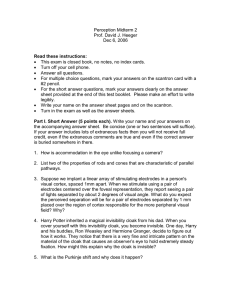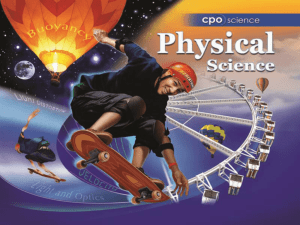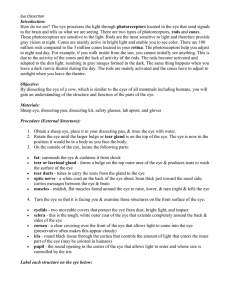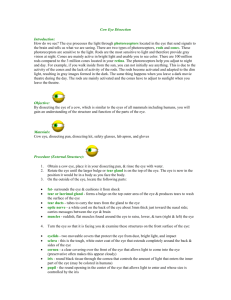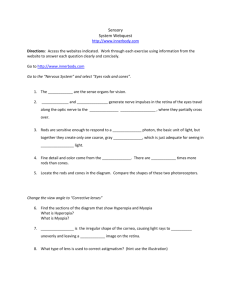Midterm 2 answers
advertisement
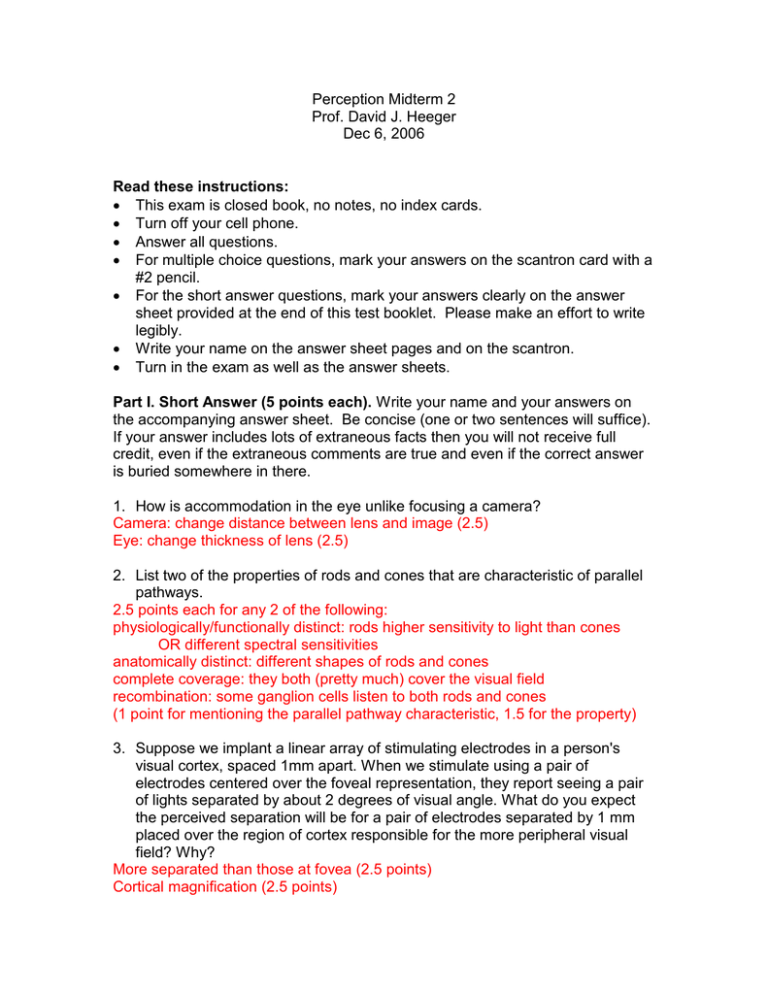
Perception Midterm 2 Prof. David J. Heeger Dec 6, 2006 Read these instructions: This exam is closed book, no notes, no index cards. Turn off your cell phone. Answer all questions. For multiple choice questions, mark your answers on the scantron card with a #2 pencil. For the short answer questions, mark your answers clearly on the answer sheet provided at the end of this test booklet. Please make an effort to write legibly. Write your name on the answer sheet pages and on the scantron. Turn in the exam as well as the answer sheets. Part I. Short Answer (5 points each). Write your name and your answers on the accompanying answer sheet. Be concise (one or two sentences will suffice). If your answer includes lots of extraneous facts then you will not receive full credit, even if the extraneous comments are true and even if the correct answer is buried somewhere in there. 1. How is accommodation in the eye unlike focusing a camera? Camera: change distance between lens and image (2.5) Eye: change thickness of lens (2.5) 2. List two of the properties of rods and cones that are characteristic of parallel pathways. 2.5 points each for any 2 of the following: physiologically/functionally distinct: rods higher sensitivity to light than cones OR different spectral sensitivities anatomically distinct: different shapes of rods and cones complete coverage: they both (pretty much) cover the visual field recombination: some ganglion cells listen to both rods and cones (1 point for mentioning the parallel pathway characteristic, 1.5 for the property) 3. Suppose we implant a linear array of stimulating electrodes in a person's visual cortex, spaced 1mm apart. When we stimulate using a pair of electrodes centered over the foveal representation, they report seeing a pair of lights separated by about 2 degrees of visual angle. What do you expect the perceived separation will be for a pair of electrodes separated by 1 mm placed over the region of cortex responsible for the more peripheral visual field? Why? More separated than those at fovea (2.5 points) Cortical magnification (2.5 points) 4. Harry Potter inherited a magical invisibility cloak from his dad. When you cover yourself with this invisibility cloak, you become invisible. One day, Harry and his buddies, Ron Weasley and Hermione Granger, decide to figure out how it works. They notice that there is a very fine and intricate pattern on the material of the cloak that causes an observer’s eye to hold extremely steady fixation. How might this explain why the cloak is invisible? Retinal Stabilization (2.5 points) Stabilized Images don’t make it to conscious perception (2.5 points) 5. What is the Purkinje shift and why does it happen? Shift in appearance of brightest color from scotopic to photopic conditions (1.5 points) From yellow to blue (1 point) Because of shift in maximum spectral sensitivity of rods versus cones (1.5 points) Rod max at shorter wavelength than cone max (1 point) Part II. Multiple Choice (2.5 points each). Write your name on the accompanying scantron card and fill in the circles using a #2 pencil. 1) As light passes through the eye to the retina, it passes through a number of structures. Which of the following lists the structures in the proper order? a) pupil, cornea, lens, bipolar cells, ganglion cells, photoreceptors. b) cornea, pupil, lens, ganglion cell, bipolar cells, photoreceptors. c) cornea, pupil, lens, photoreceptors, bipolar cells, ganglion cells. d) cornea, pupil, lens, bipolar cells, photoreceptors, ganglion cells. e) cornea, pupil, lens, bipolar cells, ganglion cells, photoreceptors. 2) Two objects of different sizes can never subtend the same visual angle. a) True b) False 3) Which of these statements about the eye are true? a) The lens is the primary source of optical focusing power. b) The cornea receives nutrients through tiny transparent blood vessels. c) The lens allows for adjustable focus to nearby and distant objects. 4) What is the primary cause of visual deficits that require people (soon to be Prof. Heeger) to need reading glasses when they get to be in their 40s or 50s even though they always had perfect vision when they were younger? a) glaucoma b) macular degeneration c) stiffening of the lens d) astigmatism e) cataracts 5) If you are near-sighted, your eyeball is likely too ____, and if you are farsighted, your eyeball is likely too ____. This means that near-sighted observers need glasses to correct light from focusing ____ the retina. a) shortened; elongated; in front of b) shortened; elongated; behind c) elongated; shortened; in front of d) elongated; shortened; behind 6) Which of the following cell types fires action potentials? a) photoreceptors b) horizontal cells c) bipolar cells d) ganglion cells 7) The fovea does not contain which of the following? a) pigment epithelium b) photopigment c) rods d) cones 8) Which of these statements are true about people with no cone vision? a) They are color-blind. b) They require bright lights to see anything. c) Their acuity in the fovea is normal, but they have marked deficits in peripheral acuity d) a and b 9) The visual photopigments a) become transparent in the dark. b) regenerate in the dark. c) are the same in rods and cones. d) are located in the pigment epithelium. 10) One of the problems with pinhole camera optics is that if the hole is too small, then the image will be blurry. a) True. b) False. 11) The time course of dark adaptation a) is rather fast and depends exclusively on the mechanism known as "pupil dilation". b) is fast because the rhodopsin molecules in the rods are regenerated quickly. c) has two phases, one corresponding to adaptation in the cones and the other corresponding to adaptation in the rods. d) does not depend on rods and cones. 12) The receptive field of a neuron has an OFF center and ON surround. Which of the following stimuli will evoke the greatest response? a) bright spot of light in the center with gray in the surround. b) bright spot in the center with dim light in the surround. c) dim spot in the center with gray in the surround. d) dim spot in the center with bright light in the surround. 13) Which of the following is not a characteristic of parasol (also called magnocellular) ganglion cells? a) receive inputs from many photoreceptors b) combine photoreceptors inputs regardless of cone class c) are involved in fast visual processing d) have high spatial resolution 14) What is it with Mona Lisa's smile? When you look at Mona Lisa's eyes, she appears to smile, but when you look directly at her mouth, the smile disappears. One of the best explanations for Mona Lisa's disappearing smile is: a) the high spatial acuity of peripheral vision is necessary to perceive Mona Lisa's smile. b) the high spatial acuity of foveal vision is necessary to perceive Mona Lisa's smile. c) the low spatial acuity of peripheral vision blurs Mona Lisa's mouth into a smile. d) the low spatial acuity of foveal vision blurs Mona Lisa's mouth into a smile. 15) Which of the following does not contribute to perceived brightness? a) light adaptation. b) center-surround receptive fields. c) whether or not a surface is perceived as being behind a transparent filter. d) whether or not a surface is perceived to be oriented toward or away from the light source. e) All of the above contribute to perceived brightness. 16) Metamers a) are two lights that have different spectral power distributions but appear the same color. b) are two lights with different brightness that appear to have the same color. c) are two lights, which appear the same color under both light and darkadapted conditions. d) are lights that are “opponent” such as blue and yellow. 17) The light distribution near a border is shown below. The perceived brightness caused by this distribution will be a) greatest at a. b) greatest at b. c) greatest at c. d) the same at a and b. 18) If an object has the reflectance curve shown below, it will most likely appear to be: a) blue b) red c) purple d) yellow 19) Mary has a genetic defect such that she only has S-cone photoreceptors. If she does a color matching task where she could adjust 2 knobs to vary the intensities of purple and yellow lights to match a green test light, then there is(are)______ that would result in a match. a) an infinite set of knob settings b) two knob settings c) exactly one knob setting d) no knob settings 20) Which of the following stimuli would result in an afterimage of a red square on a blue background? a) a yellow square on a green background. b) a green square on a yellow background. c) a blue square on a red background. d) a green square on a blue background. 21) The anatomical locus where the optic nerves from the two eyes converge is called the a) optic tract b) lateral geniculate nucleus c) optic chiasm d) optic radiation 22) The neurons in primary visual cortex (V1) are organized by: a) receptive field location. b) ocular dominance. c) orientation preference. d) all of the above. 23) Complex cells respond best to _____ of light. Hypercomplex cells, unlike complex cells, have the additional property of _____. a) bars, end-stopping b) bars, spatial summation c) spots, inhibitory flanks d) spots, spatial summation e) transient flashes, direction selectivity 24) We place a microelectrode in the LGN at position 1 indicated diagram, record from an LGN neuron, and find that its receptive field is located as marked by the “1” in the diagram of the visual fields. Then we move the electrode to position 2 in the LGN and record from another LGN neuron. Choose the most likely location for its receptive field. (a) 25) A patient comes to see his doctor complaining of vision problems. Upon examination, the doctor finds that the man has a visual deficit in the lowerright quadrant of his left-eye visual field. The doctor should refer this patient to the: a) ophthalmologist because he has a problem in the retina of his left eye. b) neurologist because he has a problem in the left hemisphere of his brain. c) neurologist because he has a problem in the right hemisphere of his brain. 26) Which of the following could result from disparities lying outside of Panum's fusional area? a) stereopsis b) strabismus c) amblyopia d) diplopia 27) You are fixating on an object directly in front of you, 2 feet away. While still fixating on the object in front of you, you notice something moving in a far corner of the room. The object in the corner of the room: a) has uncrossed disparity. b) has crossed disparity. 28) The full moon appears larger when it is close to the horizon compared to when it is high above the horizon. This percept occurs because: a) the moon's orbit takes it further from the earth when it is at the horizon, thus subtends a smaller visual angle from when it is high above the horizon. b) the moon's orbit takes it closer to the earth when it is at the horizon, thus subtends a larger visual angle from when it is high above the horizon c) depth cues along the horizon make the moon appear to be farther away (thus larger) despite the fact that the moon subtends the same visual angle at the horizon and above the horizon. d) depth cues along the horizon make the moon appear closer (thus larger) despite the fact that the moon subtends the same visual angle at the horizon and above the horizon. 29) Which of the following is incorrect about motion perception and cortical area MT? a) Direction-selective neurons in MT respond when a pattern moves in the neuron’s preferred direction, regardless of what the pattern is. b) Neurons near one another in visual area MT are selective for similar motion directions. c) Electrical stimulation of MT neurons can bias the perception of motion. d) Lesioning a monkey’s MT cortex will impair the monkey’s ability to discriminate motion direction. e) All of the above are true statements. 30) A patient with akinetopsia will be impaired on many visual tasks. Which of the following tasks will not be problematic for such a person? a) performing smooth pursuit eye movements b) identifying objects defined by motion cues c) making saccades d) reaching for moving objects Perception Midterm 2 Answer Sheet Name: Dec 6, 2006
